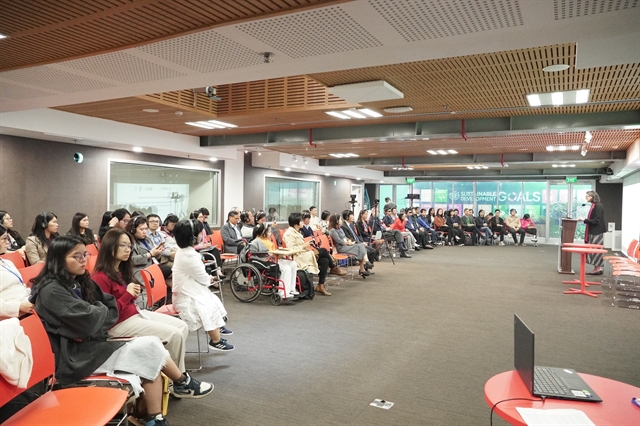
|
| Delegates participating in the conference on the launch of the study “Assessment of disability inclusion in local governance in 2023” held in Hà Nội on Thursday, December 7. — Photo courtesy of UNDP Việt Nam |
HÀ NỘI – People with disabilities (PWDs) have a low level of engagement disaster risk management and access to information, according to a UNDP study.
The UN Development Program (UNDP) in collaboration with the Mekong Development Research Institute (MDRI), yesterday in Hà Nội presented key findings of the study “Assessment of Disability Inclusion in Local Governance in 2023.”
Addressing broader issues of disability inclusion in public administration and services, the study highlights critical challenges in two key themes: access to information and responses to natural disasters.
This comprehensive study conducted from July to November 2023, offers invaluable insights into the state of disability inclusion in Việt Nam’s local governance.
It is part of the UNDP flagship PAPI research programme (the Việt Nam Provincial Governance and Public Administration Performance Index) and is supported by the Australian Government Department of Foreign Affairs and Trade (DFAT).
The study showed that only 5.3 per cent of respondents who are affected by disasters have had a chance to express concerns about local disaster risk management in the past five years.
The regions that are most affected by the natural disasters of floods, storms/tornadoes, droughts, hail and landslide are North Central Coast, Northern Midlands & Mountains, and Central Highlands.
Among PWDs, 24.5 per cent were affected by natural disasters and most of the affected PWDs rated the impact of the disasters as “severe” or “extremely severe”.
This low engagement was attributed, in part, to a shortage of accessible information regarding disaster warnings.
At present, the channels of warning are television, local loudspeakers, families/neighbours and local officials.
However, of the 38.5 per cent of PWDs not receiving warnings, disaggregated by disability type, mental and psychiatric and intellectual PWDs account for the highest rates of 21.1 and 23.6, respectively.
The hearing-and-speech and visual PWDs are also the groups facing difficulty accessing warning channels of TV and local loudspeakers.
The findings underscore the urgent need for improved communication strategies in disaster preparedness to ensure the safety and well-being of persons with disabilities.
The research team recommended that it is necessary to integrate accessible information dissemination methods for PWDs in the natural disaster risk response process.
Township-level governments and local associations should strengthen their role in supporting PWDs in responding to natural disaster risks, and in being a two-way information channel connecting PWDs and local authorities.
The participation of PWDs in responding to disaster risks through local organizations, associations, and groups of PWDs should also be enhanced.
The relevant agencies should further organise training for PWDs on how to prevent and respond to natural disaster risks in frequently affected areas.
Along with low level of engagement disaster risk management, the PDWs also face discrepancies in disability classification.
The assessment revealed a significant disparity in disability classification, with individuals falling under the sixth category, “other,” surpassing those in the remaining five categories by 1.5 to two times.
The lack of proper certification for these disabilities has emerged as a major hindrance, impeding persons with disabilities (PWDs) from accessing their rights and entitlements.
The study also showed that the PWDs had digital challenges in administrative processes.
More than 20 per cent of respondents encountered obstacles in conducting administrative processes on public e-portals.
Factors such as insufficient digital skills, the absence of smart devices, platform inaccessibility, and unsynchronised databases in the digital transformation were identified as key contributors.
This digital divide forces many PWDs to rely on caregivers or Organisations of Persons with Disabilities (OPDs) to access essential social welfare information.
UNDP Resident Representative Ramla Khalidi underscored the importance of policy implementation, emphasising a people-centred approach as the pre-requisite.
“To enhance policy implementation, it is crucial to prioritise further awareness raising and provide training on disability inclusion in administrative procedures and public services for local authorities, persons with disabilities, and their representative organisations,” Khalidi said.
The launch of the assessment coincides with the International Day of Persons with Disabilities on December 3, amplifying voices of people with disabilities: focusing on the perspectives of PWDs in local public services and administrative procedures.
It also calls for actions to improve disability inclusion, urging stakeholders to take tangible steps in enhancing disability inclusion in local public governance to align with Sustainable Development Goal 16 on promoting just, peaceful, and inclusive societies. VNS
- Reduce Hair Loss with PURA D’OR Gold Label Shampoo
- Castor Oil Has Made a “Huge” Difference With Hair and Brow Growth
- Excessive hair loss in men: Signs of illness that cannot be subjective
- Dịch Vụ SEO Website ở Los Angeles, CA: đưa trang web doanh nghiệp bạn lên top Google
- Nails Salon Sierra Madre
 VnExpress News The News Gateway of Vietnam
VnExpress News The News Gateway of Vietnam





